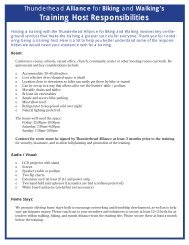2007 Benchmarking Report - Alliance for Biking & Walking
2007 Benchmarking Report - Alliance for Biking & Walking
2007 Benchmarking Report - Alliance for Biking & Walking
Create successful ePaper yourself
Turn your PDF publications into a flip-book with our unique Google optimized e-Paper software.
8<br />
Bicycling & <strong>Walking</strong> in the U.S./ Thunderhead <strong>Alliance</strong> <strong>2007</strong><br />
EXECUTIVE SUMMARY<br />
average, 0.4% of all trips to work in the U.S. are by bicycle. Although<br />
it is difficult to determine bicycle mode share <strong>for</strong> all trips<br />
because of limited data, the National Household Travel Survey<br />
(NHTS) estimates that 0.90% of all trips are by bike nationwide.<br />
Cities have slightly higher rates of cycling with approximately<br />
0.94% of all trips by bike. Looking at cycling demographics,<br />
non-white workers are only slightly more likely to bike to work<br />
than the average worker. The gap between the sexes, however,<br />
is noticeably wide. Men outnumber women cyclists 3:1. There<br />
is almost no difference in cycling rates among different income<br />
classes, suggesting that cycling is a universal activity. Fatality<br />
data indicate that cyclists are at a disproportionate risk of being<br />
killed, representing 1.7% of all traffic fatalities.<br />
Status of <strong>Walking</strong><br />
Pedestrian mode share is also higher in cities (11.0% of<br />
all trips) than nationwide (8.7% of all trips). There is a greater<br />
gap between non-white vs. white pedestrian commuters (than<br />
among cyclists), however, the gap between the sexes is minor.<br />
The pedestrian mode share also differs among income classes<br />
with the lowest income categories representing the highest<br />
number of pedestrians. However, in some places, such as New<br />
York City, there is relatively equal distribution of pedestrians<br />
among income categories, suggesting income is less of a determining<br />
factor in the choice to walk. Pedestrians are also at<br />
disproportionate risk of dying in a traffic crash, representing<br />
11% of all traffic fatalities. The disparity is even greater in cities<br />
where 11% of trips are estimated to be on foot, yet 14% of all traffic<br />
fatalities are pedestrians.<br />
Bicycling & <strong>Walking</strong> Policies and Provisions<br />
A number of policies and provisions are represented in<br />
this report including funding and staffing levels, infrastructure,<br />
written policies, and bike-transit integration. States and cities<br />
ranked poorly overall on strong policies <strong>for</strong> cycling and walking.<br />
Most cities surveyed have goals <strong>for</strong> increasing cycling and walking<br />
and <strong>for</strong> increasing cycling and walking facilities. However,<br />
most cities and states answered “no” to whether or not they had<br />
spending targets <strong>for</strong> bicycle and pedestrian projects, and most<br />
have yet to adopt a complete streets policy.<br />
Funding Bicycling and <strong>Walking</strong><br />
Officials’ responses on bicycle and pedestrian funding<br />
were extremely limited, so data from the National Transportation<br />
Enhancements Clearinghouse and the Federal Highway<br />
Administration were used to assess funding.<br />
States spend just 1.54% of their federal transportation<br />
dollars on bicycle and pedestrian projects. This amounts to<br />
just $2.50 <strong>for</strong> bicycling and walking per capita each year. The<br />
Transportation Enhancement (TE) program accounts <strong>for</strong> 73%<br />
of all bicycle and pedestrian funds. The second greatest funding<br />
category is the Congestion Mitigation and Air Quality program,<br />
representing 9% of all federal bicycle and pedestrian funding.<br />
Over 50 federal funding programs contributed to bicycle and<br />
pedestrian projects over a three year period, though most in a<br />
relatively small amount. The variations in allocation of federal<br />
dollars to bicycle and pedestrian projects among states and cities<br />
is an indicator of the role of states and local jurisdictions in<br />
determining how their federal transportation dollars are spent.<br />
Although TE is the largest funding source <strong>for</strong> bicycle and<br />
pedestrian infrastructure improvements, slightly less than 50% of<br />
these funds go towards bicycle and pedestrian projects (the remainder<br />
going to other spending categories allowed by the program).<br />
Only a very small amount of these funds <strong>for</strong> bicycle and<br />
pedestrian projects are in the “bicycle and pedestrian education<br />
and safety” category. Variation is great among cities and states in<br />
the use of these funds, with some spending 100% of TE funds on<br />
bicycle and pedestrian projects and some spending zero.<br />
Safe Routes to School is the newest federal funding<br />
source that is completely dedicated to bicycle and pedestrian<br />
safety and improvements around schools. Passed by Congress<br />
in 2005, it has limited data at this point. The states that did<br />
report on spending showed a 24:76 split between education and<br />
capital projects. Allocation of funds to education and capital projects<br />
spanned the entire allowable range.<br />
Staffing Bicycling and <strong>Walking</strong><br />
Through Thunderhead surveys, officials were asked to<br />
report the number of full-time-equivalent (FTE) staff dedicated



